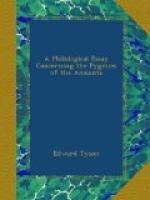Flower[A] says that “another tribe, the M’Boulous, inhabiting the coast north of the Gaboon River, have been described by M. Marche as probably the primitive race of the country. They live in little villages, keeping entirely to themselves, though surrounded by the larger Negro tribes, M’Pongos and Bakalais, who are encroaching upon them so closely that their numbers are rapidly diminishing. In 1860 they were not more than 3000; in 1879 they were much less numerous. They are of an earthy-brown colour, and rarely exceed five feet three inches in height. Another group living between the Gaboon and the Congo, in Ashangoland, a male of which measured four feet six inches, has been described by Du Chaillu.”
In Loango there is a tribe called Babonko, which was described by Battell in 1625, in the work entitled “Purchas his Pilgrimes,” in the following terms:—“To the north-east of Mani-Kesock are a kind of little people called Matimbas; which are no bigger than boyes of twelve yeares old, but very thicke, and live only upon flesh, which they kill in the woods with their bows and darts. They pay tribute to Mani-Kesock, and bring all their elephants’ teeth and tayles to him. They will not enter into any of the Maramba’s houses, nor will suffer any one to come where they dwell. And if by chance any Maramba or people of Longo pass where they dwell, they will forsake that place and go to another. The women carry bows and arrows as well as the men. And one of these will walk in the woods alone and kill the Pongos with their poysoned arrows.” It is somewhat surprising that Tyson, who gives in his essay (p. 80) the account of the same people published at a later date (1686) by Dapper, should have missed his fellow-countryman’s narrative. The existence of this tribe has been established by a German expedition, one of the members of which, Dr. Falkenstein, photographed and measured an adult male whose stature was four feet six inches.
Krapf[A] states that in the south of Schoa, in a part of Abyssinia as yet unworked, the Dokos live, who are not taller than four feet. According to his account, they are of a dark olive colour, with thick prominent lips, flat noses, small eyes, and long flowing hair. They have no dwellings, temples, holy trees, chiefs, or weapons, live on roots and fruit, and are ignorant of fire. Another group was described by Mollieu in 1818 as inhabiting Tenda-Maie, near the Rio Grande, but very little is known about them. In a work entitled “The Dwarfs of Mount Atlas,” Halliburton[B] has brought forward a number of statements to prove that a tribe of dwarfs, named like those of Central Africa, Akkas, of a reddish complexion and with short woolly hair, live in the district adjoining Soos. These dwarfs have been alluded to by Harris and Doennenburg,[C] but Mr. Harold Crichton Browne,[D] who has explored neighbouring districts, is of opinion that there is no such tribe, and that the accounts of them have been based upon the examination of sporadic examples of dwarfishness met with in that as in other parts of the world.




